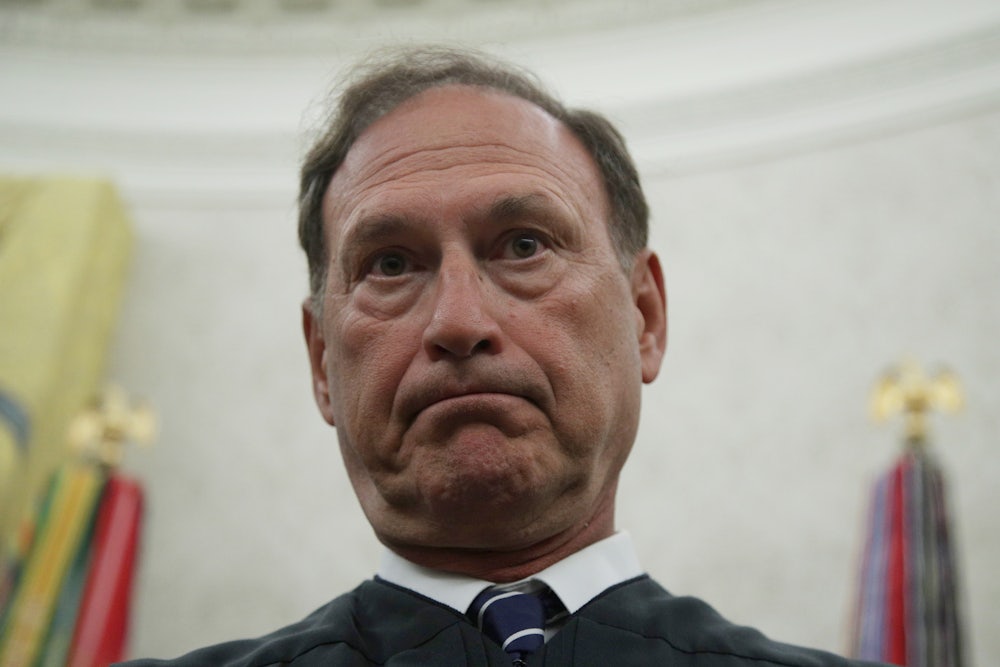Historically, when the Supreme Court strays too far from what the vast majority of the public wants and starts catering to a white Southern minority, nothing good comes of it. When the Supreme Court decided in 1857 not only that Dred Scott was not a free man but that no Black person could be a citizen of the United States or enjoy the rights afforded them by the Constitution, it doomed the country to civil war. In the process of protecting “states’ rights” for white Southerners, the Supreme Court led by Roger Taney trampled both human rights and the rights of free states to prohibit slavery on their own territory.
The echoes of the past are even clearer when you compare the language and reasoning of the Taney and the current Roberts court. The written opinion of Chief Justice Taney in Dred Scott v. Sandford relied on the same sort of “originalist” logic used by Associate Justice Samuel Alito in Dobbs v. Jackson. Indeed, this passage by Taney on why Blacks were doomed to slavery, based on an originalist reading of the Constitution, could have been written by Alito last year:
Yet the men who framed this declaration were great men—high in literary acquirements—high in their sense of honor, and incapable of asserting principles inconsistent with those on which they were acting. They perfectly understood the meaning of the language they used, and how it would be understood by others.… They spoke and acted according to the then established doctrines and principles, and in the ordinary language of the day, and no one misunderstood them.
In addition to resembling the pre–Civil War Taney court, the current Supreme Court shares some of the odious traits of the court that followed the Civil War. That court, led by Chief Justice Morrison Waite, delivered decision after decision that ended Reconstruction. In United States v. Reese, the court ruled 7–2 that “racially neutral” voter suppression measures such as poll taxes, literacy tests, and the grandfather clause were constitutional. In United States v. Cruikshank, the Waite court ruled 9–0 that the federal government had no right to arrest the people responsible for the Colfax Massacre, the 1873 Louisiana riot where dozens of Black militiamen were murdered by a white mob. The Waite court also decided unanimously in Minor v. Happersett that women do not have a constitutional right to vote.
In Elk v. Wilkins, the Waite court ruled 7–2 that being born on U.S. soil did not grant citizenship to Native Americans. The court also upheld miscegenation laws 9–0 in the 1883 case Pace v. Alabama. That same year, a majority struck down the Civil Rights Act of 1875 in The Civil Rights Cases of 1883. Later, in 1896, under Chief Justice Melville Fuller, the Supreme Court enshrined segregation via Plessy v. Ferguson, under the rubric of states’ rights.
The logic used by the court and the effects of its decisions were described eloquently by Adam Serwer in a 2018 Atlantic article: “They carefully framed their arguments in terms of limited government and individual liberty, writing opinion after opinion that allowed the white South to create an oppressive society in which black Americans had almost no rights at all. Their commitment to freedom in the abstract, and only in the abstract, allowed a brutal despotism to take root in Southern soil.”
As if to drive this point home, the Roberts court ruled in Shinn v. Ramirez that it doesn’t matter if a person is innocent based on the preponderance of the evidence; so long as procedure was followed, the state can still execute people. Justice in the abstract, and only in the abstract, all over again.
Almost 40 years passed between the Dred Scott decision and Plessy. Today, the Roberts Supreme Court is poised to do similar damage in perhaps as little as 20 years. We’ve already seen the court strike down most of the Voting Rights Act of 1965 in Shelby v. Holder (2013), and it looks ready to finish off the rest of it soon. It’s allowed states to strip Native Americans of their right to vote using the pretext of preventing voter fraud in Brnovich v. Democratic National Committee. The court decided in Gill v. Whitford (2018) that while it’s unfortunate that partisan gerrymandering undeniably ends democracy, there’s nothing it can do about it constitutionally.
At the same time, the Roberts court is elevating the dominant forces in our society while striking down the civil rights of minorities. It keeps finding that Christian organizations have a right to government money, while at the same time finding they also have a right to discriminate against LGBTQ people, Jews, etc. This is freedom in the abstract: Even if Jews and LGBTQ people were allowed to discriminate against Christians, it would have a negligible impact on Christians compared to Christians being permitted to discriminate against groups that make up much smaller percentages of the population. It is akin to saying Christians can only shop at Kroger, and Jews can only shop at Jewish-run businesses: The harm falls disproportionately on the minority groups.
We’ve also seen the court strike down Roe v. Wade, and now women in states dominated by white conservatives are paying the price in blood, pain, and death. While it may have hurt the GOP in the 2022 elections, it wasn’t enough to prevent it from taking back the House of Representatives, in great part due to effective gerrymandering in red states, and even blue states like New York are putting in place judges who oppose gerrymandering. In Moore v. Harper, the court has before it the question of whether state legislatures can unilaterally decide everything about elections, including the option of deciding who gets the states’ Electoral College votes (regardless of how the people of the state actually voted) or creating alternate slates of electors (as Donald Trump and his team were trying to do).
At the district court level, extremist judges like Reed O’Connor and Matthew Kacsmaryk allow religious legal organizations to go judge shopping to reliably get injunctions against everything. O’Connor is notorious for having issued the nationwide injunction against birth control coverage under the Affordable Care Act. Kacsmaryk, formerly a lawyer for an organization opposed to abortion, has released a series of injunctions in the past year targeting women and the LGBTQ community. With judges such as these, there’s little the federal government can do to protect women and minorities. This serves to undermine faith in the legal system at all levels, and not just the Supreme Court.
Perhaps the worst part is that the Roberts court can’t even bother with ideological consistency in pursuit of partisan goals. For instance, in Masterpiece Cake Shop and Little Sisters of the Poor, the court ruled that even the merest hint of bias or burden by the government was an intolerable evil. But when Trump instituted his “Muslim ban,” the court found in Trump v. Hawaii that it was just fine because Trump made his anti-Muslim statements while he was still only a candidate, thus it couldn’t be certain that the policy was motivated by religious animus.
All the while, the right flank of the court engages in partisan activity. Associate Justice Samuel Alito openly sneers at and mocks justices who support gun control. Clarence Thomas is married to a woman who supported overthrowing the 2020 election and publicly uses right-wing talking points about “cancel culture.” Amy Coney-Barrett served as a “handmaid” in a right-wing Christian cult. Bret Kavanaugh’s hearings painted him as a beer-swilling alleged rapist with ultrarich parents to pay off his debts incurred by his country-club lifestyle.
Faith in the Supreme Court has reached an all-time low as a result of this. When Chief Justice Roberts complains that the public no longer trusts the court, while stating that the court is impartial and that the public is wrong to be upset by its decisions, it comes across as completely out of touch with both history and reality. The Roberts court is taking us down the same pathway as the Taney and Waite courts—at an even faster pace. As a result, there’s the potential for a case to absolutely break the public’s willingness to accept court decisions, and the union in the process.
And that day is coming fast.
Blue states are going to routinely contend with efforts to overturn their gun laws, efforts that will likely be successful with this court. Thus, any attempt to limit magazine size, access by domestic abusers, concealed carry, or open carry is likely to be overturned. At the same time, red states are likely to try and ban birth control and gay marriage, as well as challenge the recently passed Respect for Marriage Act. We will also see more and more overt efforts to broaden a blanket right to discriminate for religious conservatives, while those same conservatives increasingly claim a constitutional right to more and more taxpayer dollars.
But the real Dred Scott moment will be at hand when red states begin trying to extradite people from the blue states for the crime of getting abortions, providing abortions, or providing transition-related care to transgender people. Deep blue states have been creating haven and sanctuary laws to protect women, doctors, transgender people, and parents of trans youth. Both California and Massachusetts have passed sanctuary laws that would prevent people from being extradited for seeking abortions in their states. Given that eradicating abortion and eliminating health care for trans people have become the top social policy priorities for conservatives, the reaction from powerhouses like the Heritage Foundation has been swift: They see these blue-state moves as a direct threat to their agenda.
We may already see the genesis of the case that breaks the camel’s back on the horizon. Luna Younger is a trans child who was involved in a protracted custody case in Texas. She was also supposedly the reason for Governor Abbott’s move to have Child Protective Services remove trans youth from supportive homes. Eventually, Luna’s supportive mother (a pediatrician) gained sole custody and has moved to California. Her father, Jeff Younger (a ne’er-do-well who lied about his military service, employment, and education), is demanding that the Texas politicians override the state courts and attempt to extradite her back to Texas.
Younger is a right-wing Christian authoritarian. He recently tweeted, “Want to save civilization? Take power and rule.” He also has the connections to make Texas test the legality of sanctuary state laws for women and trans people. Eventually, the Supreme Court will have to decide, are people free once they leave a state like Texas? Or do they remain property of that state forever, even if they leave? Last year the Idaho House passed a bill that would make it a felony punishable by life in prison to help a transgender person under the age of 18 to travel out of state for treatment.
Given this court, we know how it’s almost certain to answer. Just as the Taney court allowed the laws of states to reach out and take freedom away from people who fled north and west, so too would the partisan Roberts court allow these same states to extradite and incarcerate women and parents of trans youth who seek legal, necessary medical treatment elsewhere.
Which brings us to the breaking point: The California attorney general would be under heavy pressure morally and from the voters to refuse to comply. At that point, federalism, and the Union, are dead, as states refuse to recognize the legitimacy of court decisions, and the comparisons with the Taney court are complete.






